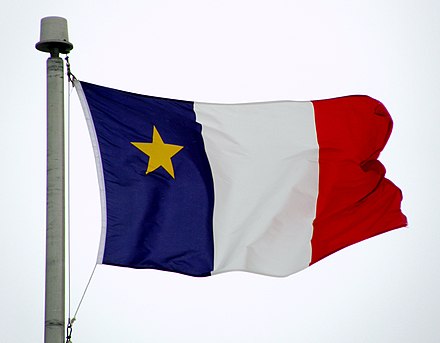Flag of Acadia
This article needs additional citations for verification. (March 2023) |
You can help expand this article with text translated from the corresponding article in French. (September 2012) Click [show] for important translation instructions.
|

The flag of Acadia is a symbolic flag representing the Acadian community of Canada. It was adopted on 15 August 1884, at the Second Acadian National Convention held in Miscouche, Prince Edward Island, by nearly 5,000 Acadian delegates from across the Maritimes. It was designed by Father Marcel-Francois Richard, a priest from Saint-Louis-de-Kent, New Brunswick. Richard's flag was a French tricolour, with a star in papal colours in the blue segment, representing devotion to the Virgin Mary – and successfully proposed that it become the Acadian national flag.[1] At that conference Richard, using military metaphors stated "At the great 1881 convention held in Memramcook, we joined together in an orderly army set for battle, not to wage war on our brothers who share our religion, but to defend ourselves against any threat made to our nationhood." He continued in stating that this army needed a banner, "a national flag".[2] The Musée Acadien at the Université de Moncton has the original flag presented by Father William to the 1884 Convention. It was sewn by Marie Babineau.[citation needed]. Also at that second convention, some suggested La Marseillaise as the Acadian Anthem, but Richard along with Pascal Poirier were successful in declaring their choice of "Ave maris stella" as the Acadian national anthem in 1884.
Design

Father Richard selected the French flag as the basis of the Acadian one to underline the adherence of the Acadians to the French civilization:
I wish that Acadia had a flag reminding not only that its children are French, but also that they are Acadians.
Father Richard saw the star in the blue band as "the distinctive emblem of our Acadian nationality", representing the star of the Blessed Virgin of the Assumption, patron of the Acadians. The star also represented the starfish that guides the sailor "through storms and reefs".[3][better source needed] The gold colour of the star was chosen by Father Richard because it is the colour of the Pope, in order to show both the adherence of the Acadians to the Roman Catholic Church and the role of the Church in the history of Acadia. [citation needed]
The flag's creation was an important part of the Acadian Renaissance, and its final design reflects the political and religious considerations of that period.[4][better source needed]
See also
Sources
- ^ "Biography – RICHARD, MARCEL-FRANÇOIS – Volume XIV (1911-1920) – Dictionary of Canadian Biography". www.biographi.ca.
- ^ "Articles | Encyclopédie du patrimoine culturel de l'Amérique française – histoire, culture, religion, héritage". www.ameriquefrancaise.org.
- ^ "Cajun and Cajuns: Genealogy site for Cajun, Acadian and Louisiana genealogy, history and culture". www.thecajuns.com.
- ^ Biddiscombe, Perry. "Le tricolour et l’étoile: The Origin of the Acadian National Flag, 1867-1912," Acadiensis 20, no. 1 (1990). Republished in P.A. Buckner, Gail Campbell, David Frank, eds., The Acadiensis Reader: Atlantic Canada after Confederation (1999). https://journals.lib.unb.ca/index.php/Acadiensis/article/download/12343/13190/